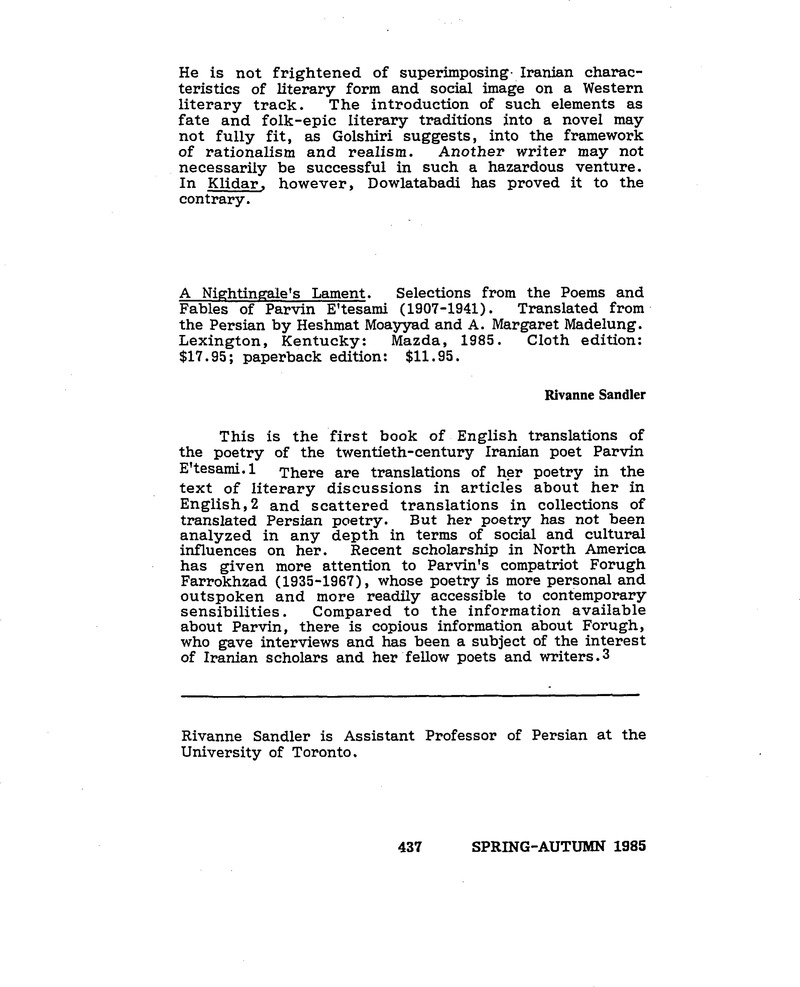No CrossRef data available.
Article contents
A Nightingale's Lament. Selections from the Poems and Fables of Parvin E'tesami (1907-1941). Translated from the Persian by Heshmat Moayyad and A. Margaret Madelung. Lexington, Kentucky: Mazda, 1985. Cloth edition: $17.95; paperback edition: $11.95.
Published online by Cambridge University Press: 01 January 2022
Abstract

- Type
- Book Reviews
- Information
- Iranian Studies , Volume 18 , Issue 2-4: Sociology of the Iranian Writer , Spring Autumn 1985 , pp. 437 - 448
- Copyright
- Copyright © Association For Iranian Studies, Inc 1985
References
Notes
1. Just under half of Parvin's total output collected in her Divan (first printing; Tehran, 1935).
2. Moayyad, Heshmat, "Parvin's Poems: A Cry in "the Wilderness," Islamwissenschaftliche Abhandberger Fritz Meier (Wiesbaden: Franz Steiner, 1974), pp. 164-190Google Scholar; Ishaque, Muhammad, Four Eminent Poetesses of Iran (Calcutta: Iran Society, 1950)Google Scholar; and "Parvin-i I'tisami: An Eminent Poetess of Modern Iran," Encyclopaedia Iranica, No. 2 (October 1948): 20-28, and Islamic Culture 3 (1943): 49-56; Rypka, Jan, History of Iranian Literature (Holland: D. Reidel, 1968)CrossRefGoogle Scholar.
3. Interviews with the poet and her letters appear in translation in Another Birth: Selected poems of Forueh Farrokhzad, translated by Hasan Javadi and Susan Sallee (Emeryville, California: Albany Press, 1981). See also Michael C. Hillmann, A Lonely Women: Forueh Farrokhzad and Her Poetry (1986).
4. Ali Akbar Dekhoda, Loghat-Nameh, P, Jascicolus 1 (Tehran, 1949), p. 292.
5. Lament, p. viii.
6. Lament, p. 204.
7. It is the translators' perception of Parvin's intent that has presumably led them to choose a translation which does not exactly match the original of the poem "Two Drops of Blood" (Lament, No. LXX; Divan, No. 187). The original reads: "Those chained ones will be freed from bonds of slavery,/if they flap their wings for release." The translation: "Captives held in servitude's chains will escape,/if, motivated by freedom's desire, they pull together."
8. Lament, p. 208.
9. Lament, p. 209.
10. Lament, p. 206.
11. Lament, p. xv.
12. Parvin's concept of education speaks to the concerns of a spiritually oriented culture: e.g., "the pursuit of knowledge" (Divan, No. 9) leads one along the path to "virtue" and "excellence." "Happy is he who makes a mixture of intelligence, acquired knowledge and good sense/ and who sustains the soul and heart with this confection" (Divan, No. 47).
13. Moayyad cites the example of the poem "O Laborer" (Lament, No. XV; Divan, No. 61) as an example of the "uncontrolled sense of boundless fury" of a disturbed heart, but untypical in its sarcastic, direct, and harsh tone (Lament, p. xxx). For Madelung, Parvin's call "for a change in the order of things" is "surprisingly uncamouflaged" in this poem (Lament, No. 212).
14. Lament, p. 202.
15. Lament, p. xii.
16. Ali Akbar Moshir Salimi, Zanan-e Sokhanvar, 3 vols. (Tehran, 1957).
17. According to Moshir Salimi, Zaran-e Sokhanvar, and Badr ol-Moluk Bamdad, From Darkness into Light, translated by F. R. C. Begley (Hicksville, New York: Exposition Press, 1977).
18. Lament, p. xiii.
19. Lament, p. xii.
20. Muhammad Ishaque, "Parvin: I'tisarri," p. 19; and Four Eminent Poetesses, p. 36.
21. Bamdad, From Darkness into Light, p. 103.
22. Moshir Salimi, Zanan-e Sokhanvar, Vol. 1, p. 258.
23. Parvin's use of the Persian language is her own as is her use of metaphors. She uses familiar images and themes in a manner all her own: e.g., under Parvin's direction, the nightingale becomes a lesson in the folly of careless behavior; the rose, in its short burst of glory, points to the transient nature of life.
24. Lament, p. xvi. But how do we know what is in Parvin's heart if she doesn't tell us.
25. Bamdad, p. 134.
26. Cf. Madelung who reads Parvin as a "revolutionary" calling "for a change in the order of things" (Lament, No. 212). Does Madelung mean a "moral" revolutionary?
27. Madelung posits a discerning audience whose members are capable of understanding what is behind Parvin's "veil of secrets"--an audience that could see through her subterfuge, through the mask behind which Parvin hid to aim her barbs at forbidden targets (Lament, No. 215).
28. Lament, p. xiii.
29. Moayyed, "A Cry in the Wilderness," p. 166.


